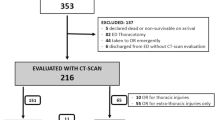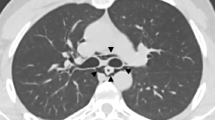Abstract
Objectives
To determine the specific CT findings of penetrating neck wound profile predicting aerodigestive injuries, diagnostic performance of CTA and to propose a modified selective management algorithm to reduce nontherapeutic invasive procedures.
Methods
We retrospectively evaluated CTAs of 102 patients to determine the presence of various CT signs. “Trajectory”-based signs included trajectory of the wound extending into the aerodigestive tract and trajectory violating the deep neck spaces. “Conventional” signs included transcervical injury; wall defect; air or blood in the deep neck spaces; irregular or thickened aerodigestive tract; and active mucosal bleeding.
Results
Trajectory of the wound extending into the aerodigestive tract (sensitivity 76 %, specificity 97 %) and trajectory of the wound violating the suprahyoid deep neck spaces or the infrahyoid visceral space (sensitivity 97 %, specificity 55 %) were the best predictors of injury on regression analysis. The most specific “conventional” CT signs were “wall defect” and “active mucosal bleed”, but had very low sensitivity. The sensitivity of CTA for detecting an injury ranged from 89.5 % to 92 %, specificity ranged from 62.5 % to 89 %.
Conclusion
CTA can be a useful technique in detecting aerodigestive injury. Our proposed management algorithm can exclude an injury with high degree of confidence (sensitivity 97 %).
Key Points
• Trajectory-based CT signs predict aerodigestive injury after penetrating neck trauma.
• Surgery should be considered when trajectory extends into the infra-arytenoid aerodigestive tract.
• Endoscopy or exploration should be considered when trajectory violates deep neck spaces.
• This modified approach can decrease negative explorations and invasive diagnostic procedures.







Similar content being viewed by others
References
Tisherman SA, Bokhari F, Collier B, Cumming J, Ebert J, Holevar M, Rhee P (2008) Clinical practice guideline: penetrating zone II neck trauma. J Trauma 64(5):1392–1405
Kesser BW, Chance E, Kleiner D, Young JS (2009) Contemporary management of penetrating neck trauma. Am Surg 75(1):1–10
Bishara R, Pasch AR, Douglas DD, Schuler JJ, Lim LT, Flanigan DP (1986) The necessity of mandatory exploration of penetrating zone II neck injuries. Surgery 100(4):655–660
Meyer JP, Barrett JA, Schuler JJ, Flanigan DP (1987) Mandatory vs selective exploration for penetrating neck trauma: a prospective assessment. Arch Surg 122(5):592–597
Asensio JA, Valenziano CP, Falcone RE, Grosh JD (1991) Management of penetrating neck injuries. The controversy surrounding zone II injuries. Surg Clin N Am 71(2):267–296
Belinkie SA, Russell JC, Dasilva J, Becker DR (1983) Management of penetrating neck injuries. J Trauma 23(3):235–237
Wood J, Fabian TC, Mangiante EC (1989) Penetrating neck injuries: recommendations for selective management. J Trauma 29(5):602–605
Gracias VH, Reilly PM, Philpott J, Klein WP, Lee SY, Singer M, Schwab CW (2001) Computed tomography in the evaluation of penetrating neck trauma: a preliminary study. Arch Surg 136(11):1231–1235
Shiroff AM, Gale SC, Martin ND, Marchalik D, Petrov D, Ahmed HM, Gracias VH (2013) Penetrating neck trauma: a review of management strategies and discussion of the ‘no zone’ approach. Am Surg 79(1):23
Woo K, Magner DP, Wilson MT, Margulies DR (2005) CT angiography in penetrating neck trauma reduces the need for operative neck exploration. Am Surg 71(9):754–758
Múnera F, Soto JA, Palacio D, Velez SM, Medina E (2000) Diagnosis of arterial injuries caused by penetrating trauma to the neck: comparison of helical CT angiography and conventional angiography. Radiology 216(2):356–362
Múnera F, Soto JA, Palacio DM, Castañeda J, Morales C, Sanabria A, García G (2002) Penetrating neck injuries: helical CT angiography for initial evaluation. Radiology 224(2):366–372
Neville AL, VanNatta TL (2012) Penetrating injury to the pharynx and cervical esophagus. In: Velmahos GC, Degiannis E, Doll D (eds) Penetrating trauma. Springer, Berlin, pp 221–228
Demetriades D, Velmahos GG, Asensio JA (2001) Cervical pharyngoesophageal and laryngotracheal injuries. World J Surg 25(8):1044–1048
Goudy SL, Miller FB, Bumpous JM (2002) Neck crepitance: evaluation and management of suspected upper aerodigestive tract injury. Laryngoscope 112(5):791–795
Chagnon FP, Mulder DS (1996) Laryngotracheal trauma. Chest Surg Clin N Am 6(4):733–748
Steenburg SD, Sliker CW, Shanmuganathan K, Siegel EL (2010) Imaging evaluation of penetrating neck injuries. Radiographics 30(4):869–886
Symbas PN, Hatcher CR Jr, Vlasis SE (1980) Esophageal gunshot injuries. Ann Surg 191(6):703
Cheadle W, Richardson JD (1982) Options in management of trauma to the esophagus. Surg Gynecol Obstet 155(3):380–384
Velmahos GC, Souter I, Degiannis E, Mokoena T, Saadia R (1994) Selective surgical management in penetrating neck injuries. Can J Surg 37(6):487–491
Asensio JA, Berne J, Demetriades D, Murray J, Gomez H, Falabella A, Berne TV (1997) Penetrating esophageal injuries: time interval of safety for preoperative evaluation-how long is safe? J Trauma 43(2):319–324
Gonzalez RP, Falimirski M, Holevar MR, Turk B (2003) Penetrating zone II neck injury: does dynamic computed tomographic scan contribute to the diagnostic sensitivity of physical examination for surgically significant injury? A prospective blinded study. J Trauma 54(1):61–65
Mazolewski PJ, Curry JD, Browder T, Fildes J (2001) Computed tomographic scan can be used for surgical decision making in zone II penetrating neck injuries. J Trauma 51(2):315–319
Inaba K, Branco BC, Menaker J et al (2012) Evaluation of multidetector computed tomography for penetrating neck injury: a prospective multicenter study. J Trauma 72(3):576–584
Acknowledgments
Presented at ARRS 2015. The scientific guarantor of this publication is Bodanapally, Uttam, K, MBBS. The authors of this manuscript declare no relationships with any companies whose products or services may be related to the subject matter of the article. The authors state that this work has not received any funding. No complex statistical methods were necessary for this paper. Institutional review board approval was obtained. Written informed consent was waived by the institutional review board. Methodology: retrospective, diagnostic or prognostic study, performed at one institution.
Author information
Authors and Affiliations
Corresponding author
Rights and permissions
About this article
Cite this article
Bodanapally, U.K., Shanmuganathan, K., Dreizin, D. et al. Penetrating aerodigestive injuries in the neck: a proposed CT-aided modified selective management algorithm. Eur Radiol 26, 2409–2417 (2016). https://doi.org/10.1007/s00330-015-4050-3
Received:
Revised:
Accepted:
Published:
Issue Date:
DOI: https://doi.org/10.1007/s00330-015-4050-3




